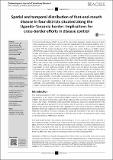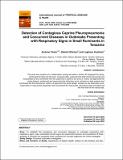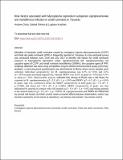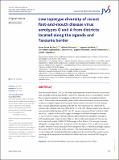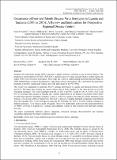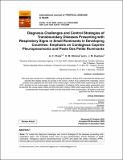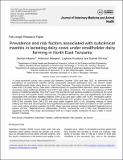Search
Now showing items 1-10 of 13
Spatial and temporal distribution of foot-and-mouth disease in four districts situated along the Uganda-Tanzania border: Implications for cross-border efforts in disease control.
(AOSIS, 2018-08-27)
Foot-and-mouth disease (FMD) is one of the major trans-boundary animal diseases in East Africa causing economic loss to farmers and other stakeholders in the livestock industry. Foot-and-mouth disease occurs widely in both ...
Detection of Contagious Caprine Pleuropneumonia and Concurrent Diseases in Outbreaks Presenting with Respiratory Signs in Small Ruminants in Tanzania
(International Journal of TROPICAL DISEASE & Health, 2020-07-06)
Aims: To establish the prevalence and concurrent diseases in outbreaks presenting with respiratory signs, major associated clinical signs and postmortem lesions and proportions of those diseases in clinically and autopsied ...
Risk factors associated with Mycoplasma capricolum subspecies capripneumoniae and morbillivirus infection in small ruminants in Tanzania.
(Springer Nature Switzerland AG., 2019-09-01)
Mortality of domestic small ruminants caused by contagious caprine pleuropneumonia (CCPP) and Peste des petits ruminants (PPR) is frequently reported in Tanzania. A cross-sectional survey was conducted between June, 2016 ...
Low topotype diversity of recent foot-and-mouth disease virus serotypes O and A from districts located along the Uganda and Tanzania border.
(The Korean Society of Veterinary Science, 2019-03-01)
Foot-and-mouth disease (FMD) is one of the most important livestock diseases in East Africa with outbreaks reported annually that cause severe economic losses. It is possible to control disease using vaccination, but ...
Detection of peste des petits ruminants and concurrent secondary diseases in sheep and goats in Ngorongoro district, Tanzania
(Springer, 2018-11-15)
Small ruminants play an important role in the livelihoods of resource-constrained communities. This study was initiated because of a massive outbreak of a respiratory disease in sheep and goats in Loliondo area in Ngorongoro ...
Occurrence of Foot-and-Mouth Disease Virus Serotypes in Uganda and Tanzania (2003 to 2015): A Review and Implications for Prospective Regional Disease Control
(Journal of Agricultural Science, 2020-05-15)
Endemic foot-and-mouth disease (FMD) presents a global economic challenge to the livestock industry. The
progressive control pathway for FMD (PCP-FMD) specifies successive steps through which a country/region can
reduce ...
Diagnosis Challenges and Control Strategies of Transboundary Diseases Presenting with Respiratory Signs in Small Ruminants in Developing Countries: Emphasis on Contagious Caprine Pleuropneumonia and Peste Des Petits Ruminants
(International Journal of TROPICAL DISEASE & Health, 2020-12-31)
Aims: To review the diagnosis challenges and control strategies of the diseases presenting with respiratory signs. The emphasis being more on two transboundary animal diseases of small ruminants; contagious caprine ...
Prevalence and risk factors associated with subclinical mastitis in lactating dairy cows under smallholder dairy farming in North East Tanzania
(Academic Journals, 2021-03-01)
A cross-sectional survey was carried out between October 2016 and May 2017 to determine the prevalence of subclinical mastitis (SCM), associated bacterial pathogens and risk factors under smallholdersmall holder dairy farms ...
The first genotype II African swine fever virus isolated in Africa provides insight into the current Eurasian pandemic
(Scientific Reports, 2021-06-22)
African swine fever (ASF) caused by the African swine fever virus (ASFV) is ranked by OIE as the most important source of mortality in domestic pigs globally and is indigenous to African wild suids and soft ticks. Despite ...
Entomopathogenic fungi (Aspergillus oryzae) as biological control agent of cattle ticks in Tanzania
(Academic Journals, 2022-07-31)
Ticks are the most important ectoparasites that are responsible for severe economic losses in livestock
industry. The use of chemical acaricides is the most common method used to control ticks in livestock.
This study ...

